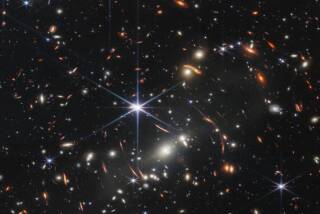SCIENCE WATCH : Hubble’s Law
- Share via
A couple of hundred miles out in space the Hubble Space Telescope could help create a replacement for Murphy’s Law, which teaches that if anything can go wrong, it will.
Hubble’s Law would say that if anything can go wrong, it will, but it might be fixed.
The Hubble Space Telescope was put into orbit last year and was designed, among other missions, to pick up the faint light still glowing from the beginning of time.
Hubble was launched without a test of the workmanship, so its $1.5 billion worth of magnifying mirrors were in orbit before discovery of the manufacturing error in the primary mirror that left everything blurred.
This outrageous blunder was crushing news for cosmology. Theories about the creation and formation of the universe have been tested for years by observation through telescope. And some of what astronomers see conflicts with some of the theories.
Since launch, astronomers and engineers at NASA have found that Hubble is not entirely helpless. It has made the most precise measurement so far of the distance to the Milky Way’s closest neighbor, a galaxy known as the Large Magellanic Cloud--an important new clue to the size and age of the universe.
Engineers think that, for a fraction of the telescope’s cost, they might be able to send astronauts in a few years to replace some of the flawed equipment. If successful, those fixes would make it possible for Hubble to carry out its original mission.
That also would give all of the cosmological theorists a few more years in which to claim to be right.






